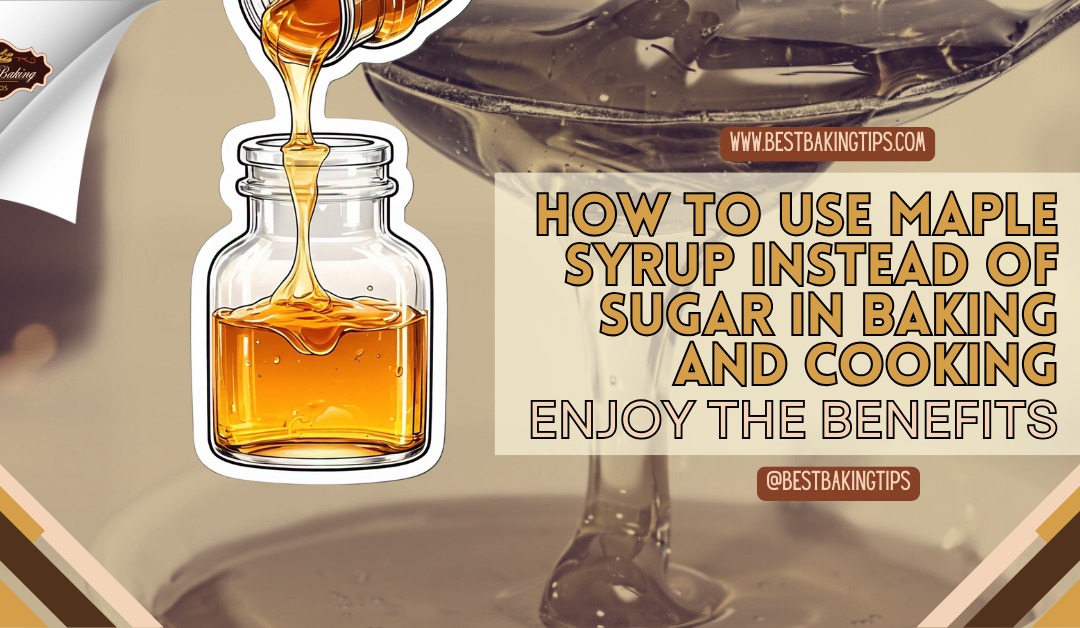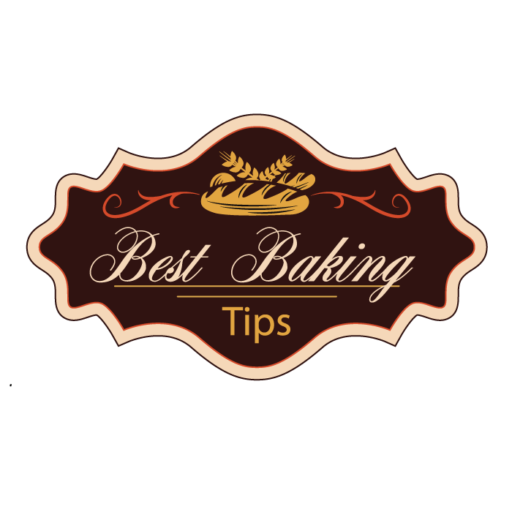==================
Affiliate Statement
Best Baking Tips is supported by our audience. When you purchase through one of our links, we may earn a small affiliate commission. As an Amazon Associate I earn from qualifying purchases. Your cost is not affected.
==================
How to use maple syrup instead of sugar offers a delicious and natural alternative to refined sweeteners, adding a rich depth of flavor to your favorite recipes. Whether you’re baking cookies, making sauces, or sweetening your morning coffee, this golden liquid can transform ordinary dishes into extraordinary delights. Unlike processed sugar, maple syrup comes packed with nutrients like manganese and zinc, offering both sweetness and health benefits. You can enjoy guilt-free indulgence while maintaining a wholesome lifestyle by learning how to substitute maple syrup for sugar.
This guide explores the art of using maple syrup in baking and cooking, ensuring your dishes are perfectly balanced and bursting with flavor. You’ll uncover tips for adjusting recipes, maintaining the right texture, and unlocking the full potential of this natural sweetener. Whether you’re a seasoned chef or a home cook looking to experiment, you’ll find everything you need to make the switch seamlessly. Ready to elevate your culinary creations with a touch of maple magic? Let’s get started!
Transform Your Baking with Maple Syrup: A Healthier, Flavorful Twist
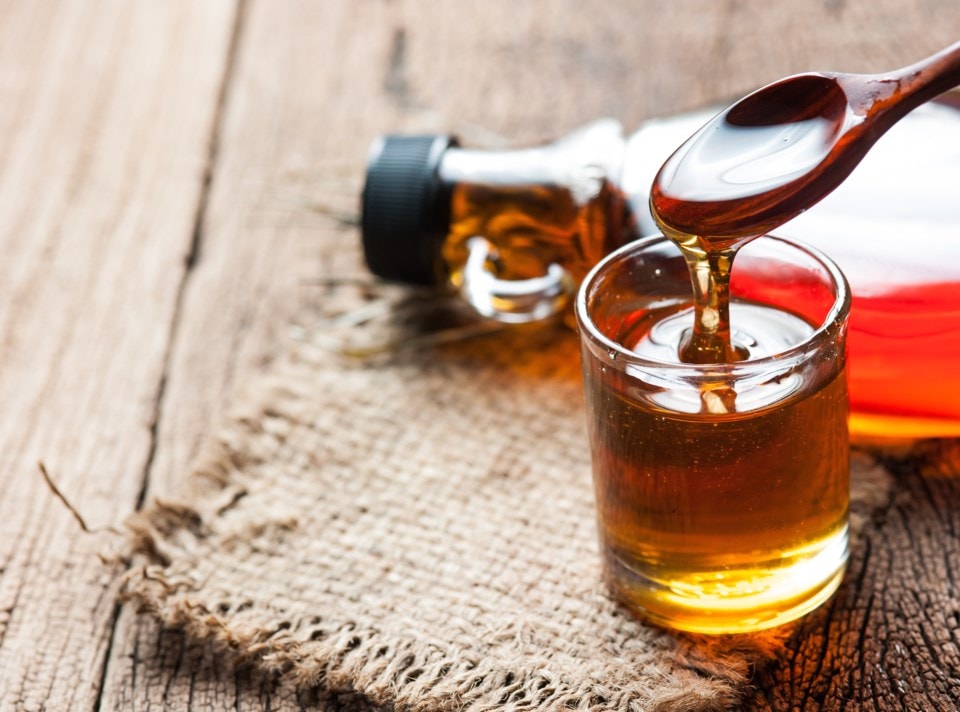
Maple syrup isn’t just for pancakes anymore! I’ve discovered that this golden elixir can be a tasty and natural alternative to sugar in many recipes. Its rich, caramel-like flavor adds depth to dishes, making them more interesting.
When learning how to use maple syrup instead of sugar in baking, use 3/4 to 1 cup of syrup for every cup of sugar the recipe calls for. I’ve found this works well in most cases. It’s important to remember that maple syrup is liquid, so I usually reduce other liquids in the recipe by about 3 tablespoons per cup of syrup.
I love using maple syrup in fall treats like pumpkin bread or oatmeal muffins. The unique flavor shines in these comfort foods. Plus, I feel good knowing I’m using a more natural sweetener that might have some added health benefits compared to refined sugar.
Key Takeaways
- Maple syrup is a natural alternative to refined sugar, packed with nutrients like manganese and zinc. When used in moderation, it provides a healthier option for adding sweetness to your dishes.
- Maple syrup adds a rich, caramel-like flavor to sweet and savory recipes. It works wonderfully in baked goods, roasted vegetables, and even marinades.
- Reduce other liquids by 3 tablespoons per cup of syrup when using maple syrup instead of sugar in baking. Also, lower the oven temperature by 25°F to prevent over-browning.
- Maple syrup isn’t just for desserts—it enhances various dishes. From breakfast items to savory meals, it brings a unique depth of flavor to any recipe.
- Baked goods made with maple syrup tend to be moist and rich in flavor. The syrup’s subtle caramel and woodsy notes are ideal for autumn treats like muffins and cookies.
The Basics of Maple Syrup as a Sugar Substitute

Maple syrup is a tasty natural sweetener that can replace sugar in many recipes. If you’re wondering how to use maple syrup effectively, I’ve found it adds a unique flavor and some health benefits, too. Let’s explore how to use maple syrup instead of sugar.
Understanding Maple Syrup and Its Properties
Maple syrup is a liquid sweetener made from the sap of maple trees. It’s less processed than white sugar and contains some minerals. I love its rich, caramel-like taste.
When I bake with maple syrup, I use about 3/4 cup for every cup of sugar a recipe calls for. It’s important to reduce other liquids by about 3 tablespoons per cup of syrup used.
Maple syrup works well in place of white sugar, brown sugar, honey, or molasses. I find it especially good in fall recipes like pumpkin bread.
Health Considerations: Glycemic Index and Nutritional Content
Maple syrup has a lower glycemic index than white sugar. This means it doesn’t raise blood sugar as quickly. I appreciate this when I want a healthier sweet treat. It also contains some nutrients:
- Calcium
- Potassium
- Manganese
- Antioxidants
While it’s still high in sugar, these extras make it better than plain white sugar. I wouldn’t call it healthy food, but it’s a nice alternative sometimes.
Comparing Sweetness Levels and Flavor Profiles
Maple syrup is about as sweet as sugar but with a more complex taste. I notice hints of caramel, vanilla, and sometimes a touch of woodiness. Here’s how it compares to other sweeteners:
- White Sugar: Maple syrup is slightly less sweet
- Brown Sugar: Similar sweetness, but with a deeper flavor
- Honey: About equally sweet, but with a different taste profile
I find maple syrup shines in recipes where I want a warm, cozy flavor. It’s great in oatmeal, yogurt, and baked goods like muffins or cookies.
Check out this video on how to stop using sugar in baked goods and switch to maple syrup instead.
By: Sunny Cove Farm
Practical Tips for Baking With Maple Syrup
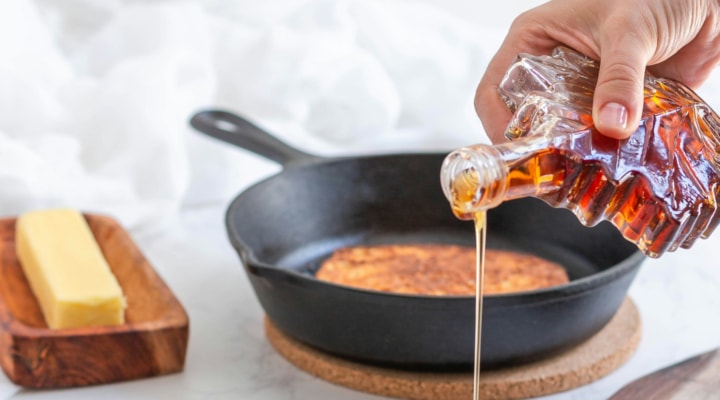
Baking with maple syrup is a great way to add natural sweetness and flavor to your treats. I’ve learned some handy tricks for using maple syrup instead of sugar. If you’re wondering how to use maple syrup effectively, let me share my top tips to help you get the best results.
Adjusting Baking Recipes for Maple Syrup
I always reduce the amount when I swap sugar for maple syrup in my baking. For every cup of sugar, I use 3/4 cup of maple syrup. This keeps my treats from being too sweet. I also lower the oven temperature by 25°F. Maple syrup can brown faster than sugar, so this helps prevent burning.
Don’t forget to cut back on other liquids too. I remove about 3 tablespoons of liquid for each cup of maple syrup I use. This keeps the batter from getting too runny. If a recipe calls for baking soda, I add 1/4 teaspoon for each cup of maple syrup. This balances out the acidity.
Managing Liquid Ingredients and Consistency
Maple syrup adds moisture to baked goods. I’ve found this can change the texture of cookies and cakes. For cookies that stay crisp, I reduce other liquid ingredients even more. Sometimes, I’ll use a bit of maple sugar instead of all syrup.
In muffins and quick breads, I embrace the extra moisture. It makes them super soft and yummy. For frostings and glazes, I might need to add a bit more powdered sugar to get the right consistency. Pure maple syrup can make them runnier than usual.
Creating a Unique Flavor Profile in Baked Goods
Maple syrup gives my baked goods a warm, cozy taste. I love pairing it with fall spices like cinnamon and nutmeg in my apple muffins.
For a deeper flavor, I use dark maple syrup. It’s great in chocolate desserts or gingerbread cookies. I’ve found maple syrup works really well with nuts, too. My maple pecan pie is always a hit at family gatherings.
For a subtle touch, I’ll use maple syrup in a glaze for my lemon pound cake. It adds just a hint of sweetness without overpowering the citrus. Remember, each brand of maple syrup can taste a bit different. I like to try a few to find my favorite for baking.
Substituting Maple Syrup for Sugar in Baking
The conversion ratio when substituting maple syrup for sugar in baking recipes is typically 1:1. For example, if a recipe calls for 1 cup of sugar, 1 cup of maple syrup can be used instead. However, because maple syrup is a liquid, it is important to reduce other liquids in the recipe by about 3 to 4 tablespoons for each cup of maple syrup used.
Using Maple Syrup in Various Types of Cooking
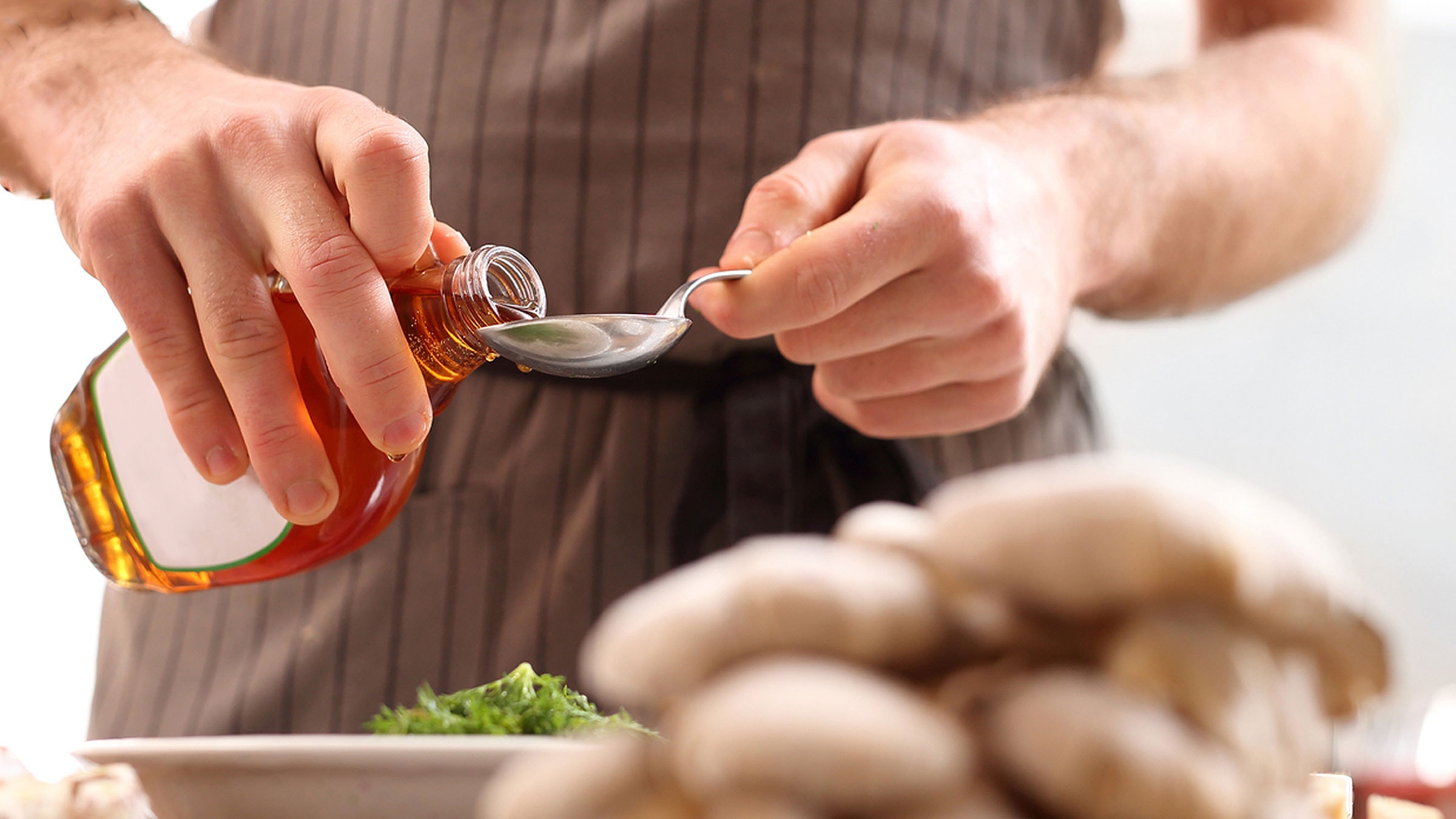
I’ve found that maple syrup is great for more than just pancakes. It’s a tasty natural sweetener that works in lots of dishes. If you’re curious about how to use maple syrup in different recipes, let me share some cool ways to use it.
Enhancing Savory Dishes With Maple Syrup
I love adding maple syrup to savory foods. It gives a nice, sweet and smoky flavor. In baked beans, I swap out brown sugar for maple syrup. It makes them extra yummy. For roasted veggies, I brush on some maple syrup near the end of cooking. It creates a tasty glaze.
Maple syrup is also great in marinades for meat. I mix it with soy sauce, garlic, and ginger for a delicious chicken marinade.
Alternatives to Sugar in Preserving Fruits and Beverages
I’ve started using maple syrup instead of sugar when making jams and preserves. It adds a unique flavor that I really enjoy.
For drinks, I love using maple syrup as a healthier sweetener. It’s great for coffee, tea, and smoothies. I also make a yummy maple lemonade. I just mix fresh lemon juice, water, and maple syrup. It’s so refreshing!
Maple Syrup as a Versatile Ingredient Beyond Sweets
Maple syrup isn’t just for desserts. I use it in lots of savory recipes, too. I love adding a splash to salad dressings. It balances out tangy vinegars really well.
For glazes, I brush maple syrup on roasted meats. It creates a beautiful caramelized crust. I even use it in place of honey sometimes. It’s great drizzled over cheese or added to homemade granola.
Elevate Baking with Maple Syrup
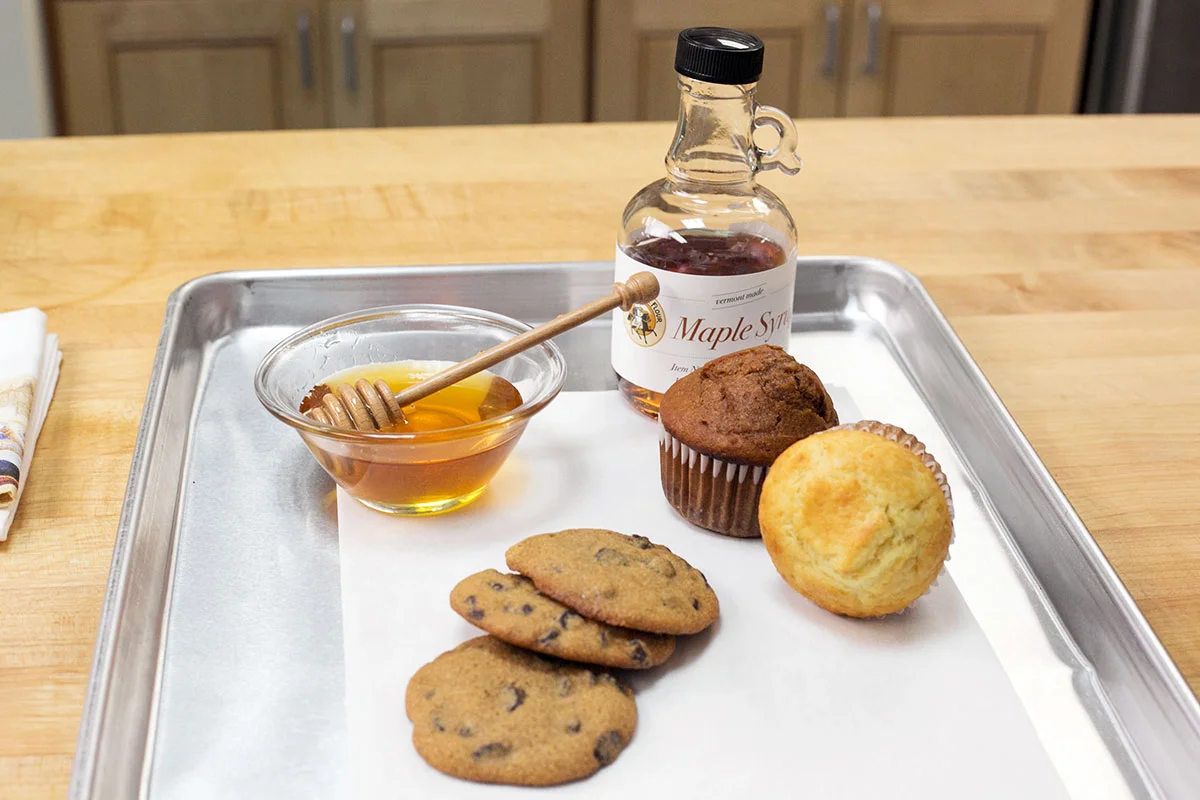
I’ve found that using maple syrup instead of sugar in baking and cooking can be a game-changer. It’s not just about replacing sugar with maple syrup but also enjoying its unique benefits.
The health benefits of maple syrup are slight compared to refined sugar, but every little bit helps! I love that it contains some minerals and antioxidants.
What really wins me over is the unique flavor profile of maple syrup. It adds a rich, caramel-like taste to my dishes that sugar just can’t match. Here are my top tips for using maple syrup in your kitchen:
- Start with small substitutions
- Adjust liquid ingredients as needed.
- Experiment with different grades of syrup
- Pair with complementary flavors like cinnamon or vanilla
Exploring how to use maple syrup in your next baking project can be an exciting way to elevate your recipes. The results may pleasantly surprise you with their rich flavor and natural sweetness!
Watch this video on 4 ways to use maple syrup.
By: Urban Platter
Unlock the Magic of Maple Syrup in Your Kitchen
Incorporating maple syrup instead of sugar into baking and cooking opens the door to a wealth of flavor and health benefits. Learning how to use maple syrup effectively allows you to enhance dishes with its unique, rich caramel-like taste, bringing depth that sugar simply can’t match. Whether used in fall-inspired treats or savory dishes like roasted vegetables and marinades, it is a versatile ingredient in the kitchen. Not only does it offer a slightly lower glycemic index than refined sugar, but it also provides trace minerals and antioxidants, making it a healthier alternative when used in moderation.
By following simple substitution tips, adjusting liquid ingredients, and experimenting with different grades of syrup, cooks of all skill levels can successfully incorporate maple syrup into their recipes. It’s not just about the sweetness; it’s about enhancing the flavor profile and creating more nutritious, exciting meals. Ready to transform your culinary creations? Let maple syrup work its magic and elevate your dishes with its distinctive sweetness and rich flavor.
Frequently Asked Questions
Let’s look at some common questions about using maple syrup instead of sugar in cooking and baking. I’ll cover conversion ratios, taste differences, recipe adjustments, and health benefits.
Can I Use Maple Syrup Instead of Sugar in My Coffee, and How Would It Affect the Taste?
Yes, I can use maple syrup in my coffee. It adds a rich, woodsy flavor that many people enjoy. I start with a small amount and adjust to taste. Maple syrup dissolves easily in hot drinks, which is nice.
In Baking, What Adjustments Should Be Made for Liquids and Oven Temperature When Using Maple Syrup as a Sweetener?
When I use maple syrup in baking, I reduce other liquids in the recipe by about 3-4 tablespoons per cup of maple syrup. I also lower the oven temperature by 25°F. This helps prevent over-browning since maple syrup caramelizes faster than sugar.
Is There a Health Benefit to Using Maple Syrup Instead of Sugar When Cooking?
Maple syrup contains some minerals and antioxidants that refined sugar doesn’t have. It has a lower glycemic index, too. But it’s still high in sugar, so I use it in moderation. It’s not a health food, just a slightly better choice than refined sugar.
How Does the Taste of Baked Goods Change When Using Maple Syrup Rather Than Sugar?
Baked goods made with maple syrup have a distinct flavor. I notice a subtle woodsy, caramel-like taste. The texture can be more moist and dense compared to using sugar. This works well in some recipes, like muffins or quick breads.
What Are Some Tips for Successfully Using Maple Syrup in Place of Honey in Recipes?
When replacing honey with maple syrup, I use the same amount the recipe calls for. Both are liquid sweeteners, so there is no need to adjust other liquids. I keep in mind that maple syrup has a thinner consistency than honey. This might affect the texture of no-bake recipes like granola bars.
Level Up Your Baking with Us!
Want to take your baking to the next level? Whether you’re just starting or have years of experience, there’s always room to grow and improve.
Join us on Facebook, Instagram, Pinterest, Twitter, and TikTok.
Become part of our vibrant baking community and learn new tips and tricks to bake irresistible treats from the comfort of your kitchen!

